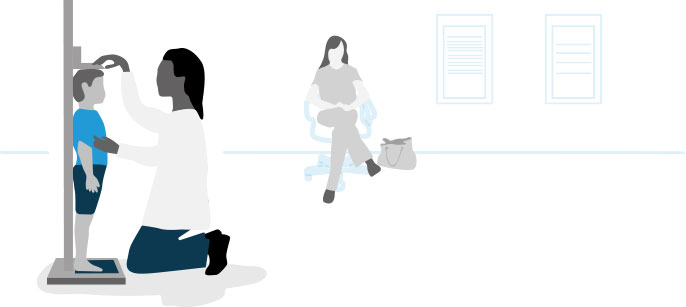Hypersensitivity Reactions Including Anaphylaxis:
Ensure that personnel administering product are adequately trained in cardiopulmonary resuscitative measures, and have ready access to emergency medical services (EMS).
If anaphylactic or other acute reactions occur, immediately discontinue the infusion of ELAPRASE and initiate appropriate medical treatment. Observe patients closely for an appropriate period of time after administration of ELAPRASE, taking into account
the time to onset of anaphylaxis seen in premarketing clinical trials and postmarketing reports. Inform patients of the signs and symptoms of anaphylaxis, and instruct them to seek immediate medical care should signs and symptoms
occur. When severe reactions have occurred during clinical trials, subsequent infusions were managed with antihistamine and/or corticosteroids prior to or during infusions, a slower rate of ELAPRASE infusion, and/or early discontinuation
of the ELAPRASE infusion.
Risk of Hypersensitivity, Serious Adverse Reactions, and Antibody Development in Hunter Syndrome Patients with Severe Genetic Mutations:
Hunter syndrome patients aged 7 years and younger with complete gene deletion, large gene rearrangement, nonsense, frameshift or splice site mutations experienced a higher incidence of hypersensitivity reactions, serious adverse reactions and anti-idursulfase
antibody development.
Risk of Acute Respiratory Complications:
Patients with compromised respiratory function or acute febrile or respiratory illness may be at higher risk of life-threatening complications from hypersensitivity reactions. Careful consideration should be given to the patient’s clinical status prior
to administration of ELAPRASE and consider delaying the ELAPRASE infusion.
Risk of Acute Cardiorespiratory Failure:
Caution should be exercised when administering ELAPRASE to patients susceptible to fluid overload, or patients with acute underlying respiratory illness or compromised cardiac and/or respiratory function for whom fluid restriction is indicated. These patients
may be at risk of serious exacerbation of their cardiac or respiratory status during infusions. Appropriate medical support and monitoring measures should be readily available during ELAPRASE infusion, and some patients may
require prolonged observation times that should be based on the individual needs of the patient.
Adverse Reactions:
In clinical trials, the most frequent serious adverse reactions following ELAPRASE treatment were hypoxic episodes. Other notable serious adverse reactions that occurred in the ELAPRASE treated patients but not in the placebo treated patients included
one case each of: cardiac arrhythmia, pulmonary embolism, cyanosis, respiratory failure, infection, and arthralgia.
The most common adverse reactions occurring in at least three patients (≥9%) aged five years and older were headache, pruritus, musculoskeletal pain, urticaria, diarrhea, and cough. The most common adverse reactions occurring in at least three patients
(≥10%) aged seven years and younger were pyrexia, rash, vomiting, and urticaria. In all clinical trials, the most common adverse reactions requiring medical intervention were hypersensitivity reactions, and included rash, urticaria,
pruritus, flushing, pyrexia, and headache.
Immunogenicity:
In clinical trials in patients 5 years and older, 32 of 63 (51%) patients tested positive for anti-idursulfase IgG antibodies (Ab) at least one time. Of the 32 Ab-positive patients, 23 of 32 (72%) tested positive for Ab at three or more different time
points (persistent Ab). The incidence of hypersensitivity reactions was higher in patients who tested positive for Ab than those who tested negative.
Thirteen of 32 (41%) Ab-positive patients also tested positive for antibodies that neutralize idursulfase uptake into cells (neutralizing antibodies, NAb) or enzymatic activity at least one time, and 8 (25%) of Ab-positive patients had persistent NAb.
There was no clear relationship between the presence of either Ab or NAb and therapeutic response.
In the clinical trial in patients 7 years and younger, 19 of 28 (68%) patients treated with ELAPRASE 0.5 mg/kg once weekly tested Ab-positive, with 16 of 19 (84%) having persistent Ab. In addition, 15 of 19 (79%) Ab-positive patients tested positive for
NAb, with 14 of 15 (93%) having persistent NAb.
Postmarketing Experience:
Late-emergent symptoms and signs of anaphylactic reactions have occurred up to 24 hours after initial treatment and recovery from an initial anaphylactic reaction. In addition, patients experienced repeated anaphylaxis over a two to four month period, up
to several years after initiating ELAPRASE treatment.
Serious adverse reactions that resulted in death included cardiorespiratory arrest, respiratory failure, respiratory distress, cardiac failure, and pneumonia.
Indications and Usage
ELAPRASE® (Idursulfase) is indicated for patients with Hunter syndrome (Mucopolysaccharidosis II, MPS II). ELAPRASE has been shown to improve walking capacity in patients 5 years and older.
In patients 16 months to 5 years of age, no data are available to demonstrate improvement in disease-related symptoms or long term clinical outcome; however, treatment with ELAPRASE has reduced spleen volume similarly to that of adults and children 5
years of age and older.
The safety and efficacy of ELAPRASE have not been established in pediatric patients less than 16 months of age.



